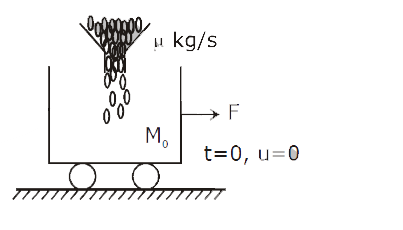A wagon is moving along a straight railway track with a velocity of 3.2 m⋅s−1. The wagon is being loaded with coal in moving condition at a rate of 540 kg.−1min. How much force is to be applied to move the wagon at a constant velocity?Assume, the initial velocity of the coal at horizontal direction is zero. Solution in Bengali
The velocity of the wagon,
v = 3.2 m⋅s−1
and the rate of change of mass of the wagon,
dmdt=540kg⋅−1min=54060kg⋅s−1=9kg⋅s−1
Hence, force to be applied on the wagon to maintain its constant velocity (acceleration, a = dvdt = 0 ) .
F=vdmdt+mdvdt=3.2×9+0=28.8 N
Topper's Solved these Questions
- BOOK - CHHAYA PUBLICATIONCHAPTER - NEWTON'S LAWS OF MOTIONEXERCISE - SECTION RELATED QUESTION10videos
NEWTON'S LAWS OF MOTION
- BOOK - CHHAYA PUBLICATIONCHAPTER - NEWTON'S LAWS OF MOTIONEXERCISE - HIGHER ORDER THINKING SKILL (HOYS) QUESTIONS26videos
NEWTON'S LAWS OF MOTION
- BOOK - CHHAYA PUBLICATIONCHAPTER - NATURE OF VIBRATIONEXERCISE - EXERCISE (CBSE SCANNER)2videos
NATURE OF VIBRATION
- BOOK - CHHAYA PUBLICATIONCHAPTER - NEWTONIAN GRAVITATION AND PLANETARY MOTIONEXERCISE - CBSE SCANNER19videos
NEWTONIAN GRAVITATION AND PLANETARY MOTION
Similar Questions
State Newton's second law of motion.
04:48View SolutionA metal ball is suspended from the roof of a train by a string. When the train is in uniform motion, will the string remain vertical? What happens to the string if the train accelerates?
02:17View Solution(i) What do you mean by resonance ? (ii) Mention any two uses of its from your daily life.
05:15View SolutionWhat is the reason for absence of atmosphere in some planets?
02:41View SolutionA loaded 20,000kg coal wagon is moving on a level track at 6ms^-1 . Suddenly 5000kg of coal is dropped out of the wagon. The final speed of the wagon is
04:01View SolutionA wagon of 200 kg is moving on a smooth track with velocity of 2 m//sec . A man of 80 kg also runs in the wagon with a velocity such that speed of the centre of mass of the system is zero. Find the velocity of man relative to the wagon (in m//s).
04:42View SolutionAn open water tight railway wagon of mass 5×10(3)kg coats at an initial velocity 1.2m/s without friction on a railway track. Rain drops fall vertically downwards into the wagon. The velocity of the wagon after it has collected103kg of water will be :-
03:07View SolutionA wagon weighing 1000 kg is moving with a velocity 50 km//h on smooth horizontal rails. A mass of 250 kg is dropped into it. The velocity with which it moves now is
02:33View SolutionAn open water tight railway wagon of mass 5×103 kg coasts at initial velocity of 1.2m/s without friction on a railway track. Rain falls vertically downwards into the wagon. What change then occurred in the kinetic energy of the wagon, when it has collected 103 kg of water
03:41View SolutionA 1000 kg engine pulls a train of 4 wagons each of 2500 kg along a horizontal railway track . If the engine exerts a force of 50000 N on wagons and track offers force of friction 10000 N, then calculate
(i) The net accelerating force
(ii) The acceleration of the train
(iii) The force of wagon -1 on wagon - 204:42View SolutionFour identical railway wagons each of m, are coupled together and rest on a smooth horizontal track. A fifth wagon of mass 2m and movingk at 5m/s collides and couple with the statioinary wagons. What is the speed of the wagons after the impact?
02:14View SolutionTwo railway wagons weighing 5000kg and 7500kg are moving at 10ms−1 and 2ms−1 in the same direction. After collision they stick together and move with the same velocity. Find the common speed and direction of motion.
View SolutionFind velocity of wagon as function of time when it is being filled with stationary hopper at the rate μ kg/sec. and constant force F is applied horizontally on the wagon as shown in figure.
M0 is the mass of the wagon and initial speed of the wagon u = 0 at time t = 0.
 02:10View Solution
02:10View SolutionA 1000 kg engine pulls a train of 4 wagons each of 2500 kg along a horizontal railway track . If the engine exerts a force of 50000 N on wagons and track offers force of friction 10000 N, then calculate
(i) The net accelerating force
(ii) The acceleration of the train
(iii) The force of wagon -1 on wagon - 202:07View Solutionমালবােঝাই করা ভারী মালগাড়ির চালক মালগাড়িকে গতিশীল করার জন্য প্রথমে সামান্য পিছনদিকে চালিয়ে পরে সামনের দিকে চালায় কেন ?
05:15View Solution

